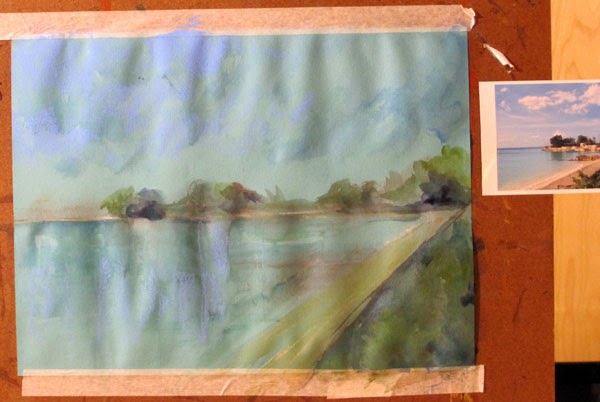Restored, hardbound and jacketed book
(There is only one rule in bookbinding:
The grain in the paper, cloth and board must run from head to tail.
City & Guilds)
Summary: This is a binding I did for an elderly lady from church. The original is a softbound book dating back to 1983 with pages which have worn thin over the years. Slightly less than half of the paper front cover still existed and, although evidently well-loved, it was looking rather sorry for itself. She told me "I use it ever such a lot!" Because of what it is and its immense value to her (not to mention her immense value to me over almost three decades), I offered to rebind it for her. The original book was yellow so I chose saffron, yellow and cream for the binding. I wrapped it up in gold and yellow tissue papers and her daughter collected it yesterday. I should have photographed it from the very beginning really but set out below are some work-in-progress images.
Work in Progress and Detail
NB. You'll see another bound book in the photographs; this was my test piece. I used a fat, unwanted novel to replicate J's book and worked on that; once each stage had dried and I was happy, I then carried out that stage on her book. The only difference is that I used craft papers for the test piece instead of expensive book-cloth; all the other materials used on both books were proper bookbinding materials - acid free paper, greyboard, mull, EVA glue, etc.
Detailed Explanation: First, I added an extra sheet of heavyweight cream paper to each end of the bookblock to protect it. This is called 'tipping in' which usually involves re-attaching a detached page with a thin strip of paste.
('Tipping in' an extra sheet)
In this case, I was merely protecting the book at each end before adding the end papers. I extended each page around the spine by 2cm so that when the page is opened you wouldn't see the book colour peeping through the endpaper and page, as is sometimes the case.
(No book colour peeping through the join.)
I then attached the end papers to the soft spine in one continuous sheet of the same cream heavyweight paper. Once dry, I added the mull which is a lightweight but stiff type of gauze that holds the spine and endpapers securely in place. (Not shown here: I cut the ends of the mull at 45 degree angles so they'd look nicer if detectable under the endpapers.) After I'd set aside the bookblock to dry, I suddenly thought to add two dark-brown ribbon bookmarks and later attached them to the mull. The correct method is to paste them to the spine underneath the mull but I made sure they were secure.

Next I cut the greyboard leaving 5mm at the 'head' and 'tail' of the book. (I cut the width exact as there needs to be an overhang of 5mm on the 'fore-edge but the boards come inwards 5mm from the spine.) To add extra strength to the book-cloth, I pasted in some of the yellow card (always following the grain rule). This 'lining' also makes the book look more attractive and finished when you look down into the spine, especially on a wide book.
(A bit wrinkly before drying tight.)
('Saffron' book-cloth from Shepherds - gorgeous colour!)
I used the bone folder (previous image) to define the spine on the outside of the case.
Rounding the spine with the bone folder gives the case a nice shape.
(There's my test piece in the background all finished!)
(Very delicate masking tape holds the case in place whilst
the book-cloth dries around the greyboard.)
You can see the 5mm overhang on the tail and fore-edge and also the way the block hangs off by 5mm into the spine; this, along with the correct spine measurement, helps the case to stay closed. When I was first told this, I had to check out some of my hardback textbooks and sketchbooks and lo and behold it was right!
(Next day, I think: different lighting conditions.)
I then added paste to the back endpaper (between the mull and the endpaper then working outwards and off the edges) and attached it to the back of the case using my hand and the bone folder to gently ease it into the exact spot. When it had dried a little, I did the same on the front and left the whole thing to dry thoroughly.
(What a lovely book, full of fascinating information!)
It opens correctly and sits flat.
(A wide jacket flap stops it being annoying!)
As the book is so well-loved and well-used, I decided to add a jacket that can easily be replaced if it starts to look untidy and it would also protect the light colour of the book. I had bought this lovely acid-free card a while ago in Cass; it turned out to be the perfect weight and colour for the job.
I then hand-wrote the title along the spine of the jacket, rather than deface the clean look of the front.
Done!
The irony is that I wanted to do something special for this kind lady but again, thanks to her, ended up doing something I absolutely love. If you've read this far, thank you! Have a successful day! xx
"The general rule is that all materials that make a book, for example paper, cloth, and board, should have their grain running from head to tail in the finished book (1) Failure to observe this rule can cause the book covers to warp when materials with opposing grains are glued together. Books with sewn sections always lie flat, and open better, if the grain of the paper in the book-block is running correctly.
(Source: City & Guilds Course in Bookbinding)







































